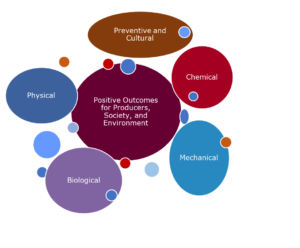Jodie Reisner, Spencer Samuelson and Muthukumar Bagavathiannan
Integrated weed management (IWM) is a diverse approach to managing weeds, which combines complementary approaches for desired weed management results (Figure 1). Studying the cultural, mechanical, physical, and biological forms in combination with chemical forms at the farm level can offer producers insights as to what can work effectively on their farms. IWM entails cultural tactics such as crop rotations, adjusting seeding rates, planting cover crops between cropping seasons to suppress weed emergence, minimizing weed seed rain through harvest weed seed control tactics, and direct control methods during the growing season to address weed pressure. With the multitude of benefits, the IWM approach promotes economic and environmental sustainability.
Figure 1: A schematic of different Integrated Weed Management options available in agriculture. Adapted by Jodie M. Reisner (image credit: www.integratedweedmanagement.org)
Role of Cover Crops as an Integrated Weed Management Tool
Cover crops support many facets of row crop production and environmental protection. Modern agriculture has reduced diversity in agroecosystems. The environmental concerns of agriculture include soil erosion, water quality issues, depletion of soil fertility and soil organic matter, and excess use of agrochemicals. Growing cover crops in association with grain crops can improve the environmental footprint of agriculture.
Cover crops are grasses, legumes, and forbs planted solely or in mixes (Figure 2) for seasonal vegetative cover (USDA, 2016). Most annual cropping systems have 4-8 months of no crop growing following the harvest of the cash crop. With the mild winters in Texas, summer weeds have an advantage of germinating and producing seed well into the fall and posing continued challenges for producers. Producers can take advantage of the long growing periods, especially that of south Texas, to plant summer cover crops in addition to the winter covers and build biomass to suppress weeds.
Ecosystem Services/Benefits
Ecosystem services can be defined as the capacity of natural processes and components to provide goods and services that satisfy human needs, directly or indirectly. Cover crops can provide healthy secure soil systems which in turn can provide quality and quantity of agricultural crops and water resources. Cover crops can improve soil carbon storage, enhance soil organic matter content, minimize greenhouse gas emissions and offer opportunities to lessen the impacts of climate change.
Reduction of soil erosion is an important ecosystem benefit of cover crops which in turn reduces nutrient and pesticide runoff into water bodies that eventually reach public water use. Further, legume covers can fix atmospheric nitrogen while cereal grains have greater success for weed suppression (Lehman et al., 2015; Thapa et al., 2018).
Protecting the high cultural value of farms in our nation and the role they play in society is important. There are currently state and national policies that recognize the public goods of ecosystem services. Cover crops play a vital role in supporting these goals.
Table 1. Cover crops as a key in cropland systems that can provide several ecosystem services. This also promotes agronomic resilience to stress factors such as drought, weed and/or pest pressure, extreme precipitation, or wind events (Kremen & Miles, 2012).
Agricultural Resources |
Benefits Offered by Cover Crops |
| Soil – fundamental foundation for agricultural ecosystems | Organic matter additions
Minimizing soil erosion Nutrient cycling Fix atmospheric nitrogen and improve soil fertility Excess nutrient capture and minimizing nutrient runoff Enhancement of soil biodiversity Improvement of overall soil health Improving overall soil health |
| Water – critical resource for agricultural production | Increase water infiltration
Decrease water run-off Decrease water evaporation Use excess water Improve farmland hydrology through capture, use, respire Protect water bodies from agrochemical and nutrient runoff
|
| Vegetation – economic, societal, and agronomic goal | Photosynthesis, carbon capture, mineralization, transformation, decomposition processes
Weed suppression residues in place from water or wind erosion
|
| Animals – Integral part of agricultural landscapes | Forage opportunities
Habitat Wildlife benefits Pollinator benefits |
| Energy – Efficient use for economic benefit | Energy savings
|
| Air – Quality for human health | Decreased dust and particulate matter movement |


